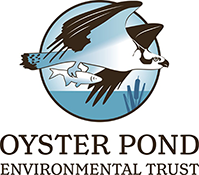About OPET
Milestones
1982 – Plan filed for subdivision of 4 parcels of land on Ransom Road by Stan Fisher family
1985-1986 Wetlands Protection Committee formed to protect the Fisher property from development
1987 – Fundraising as Oyster Pond Trust to acquire the Stan Fisher property under umbrella of Salt Pond Sanctuaries
Summer 1987 – First Year of Pond Watchers Sampling
November 1989 – First Edition of the Oyster Pond Sentinel
1994 – Oyster Pond Environmental Trust formed from Oyster Pond Trust as a 501c3 organization
May 1995 – Bylaws and Articles of Organization for OPET accepted
Summer 1995 – First Annual Meeting
Fall 1995 – First Watershed Newsletter mailed out
1997 – “A Coastal Pond Studied by Oceanographic Methods” by K.O. Emery is reissued and published by OPET with an “Epilogue: Oyster Pond- Three Decades of Change” by Brian Howes and Stan Hart
1998 – Weir is constructed to control the amount of sea water entering the Pond
2000 – OPET web site goes on line
2000 – OPET pays off debt on the Fisher Parcels, renamed Zinn Memorial Park in honor of Don and Eleanor Zinn
Winter 2001 – Jetties to Trunk River repaired and rebuilt
Fall 2003 – Wendi Buesseler joins OPET as a part time consultant
2005 – OPET initiates its own water quality sampling program
Summer 2006 – Draft Total Maximum Daily Load (TMDLs) of nitrogen to Oyster Pond produced by Massachusetts DEP Estuaries Program estimates 70% of nitrogen must be removed
Fall 2006 – Multiyear plan started to eradicate/control exotic invasive plants from the Oyster Pond Watershed (Phragmites, purple loosestrife, bush honeysuckle)
2007 – Osprey Platform raised on southwestern shore of Oyster Pond
2010 – OPET and the Falmouth Wetlands Invasives Steering Committee release 1000 Purple Loosestrife eating beetles in small marsh at the southwest corner of the pond
2011 – Americorps helps remove phragmites along the southern shoreline. Estimated 85% of phragmites in the treated area eliminated
2012 – Town of Falmouth forms Water Quality Management Committee (WQMC) to develop plans to clean up Falmouth’s estuaries, including Oyster Pond
2013 – Town WQMC hires a consultant to develop a Comprehensive Wastewater Management Plan (CWMP) for Oyster Pond. The CWMP will explore alternatives for removing excess nitrogen from Oyster Pond
2014 – OPET begins major campaign to raise $2 million to purchase 22 acres of critical land from the Woods Hole Oceanographic Institution. The land is adjacent to Zinn Park and is the headwaters to Oyster Pond
2015 – Phase 2 of the Phragmites removal campaign begins. Trunk River and the Lagoon are targeted for treatment. Nearly 95% of the phragmites in previously treated areas are eliminated
October 2015 – Thanks to many, many supporters, OPET passes papers with WHOI and completes purchase of the Headwaters of Oyster Pond! Together with Zinn Park, OPET has protected nearly 30 acres of vernal pools, wetlands and coastal forests
2016 – A hot, dry summer combined with a partially blocked Trunk River and Lagoon creates the worst algal bloom in memory in Oyster Pond. The pond turns pea soup green. OPET warns the neighbors and public to avoid contact with the water as the bloom could be toxic. OPET works with the Town to have Trunk River dredged. The increased flow in and out to Vineyard Sound along with some rain finally breaks up the bloom and it slowly disappears
2017 – To further increase the salinity in the pond to prevent another algal bloom, the Town of Falmouth removes 750 cubic yards of smelly, mucky, decaying eelgrass from the Lagoon. This increases the flow and raises pond salinity
2017 – New trails, a parking area and a kiosk are installed in the Headwaters. The new trails connect with existing trails in Zinn Park forming a 1-mile-plus loop of the lands
2017 – Town releases “Alternatives Analysis” section of the CWMP for Oyster Pond. Report explores 5 plans for removing excess nitrogen from Oyster Pond including a plan to tie 174 homes to a sewer or require 242 homes to upgrade their septic system to an Innovative/Advanced septic system
2019 – The Town selects a “Preferred Plan” that requires 189 dwellings convert their existing septic systems to an Enhanced I/A system for the “Implementation Plan” of the CWMP. The use of sewers is reserved for a “Traditional Backup Plan”

